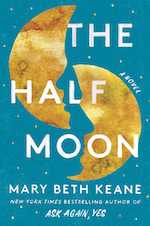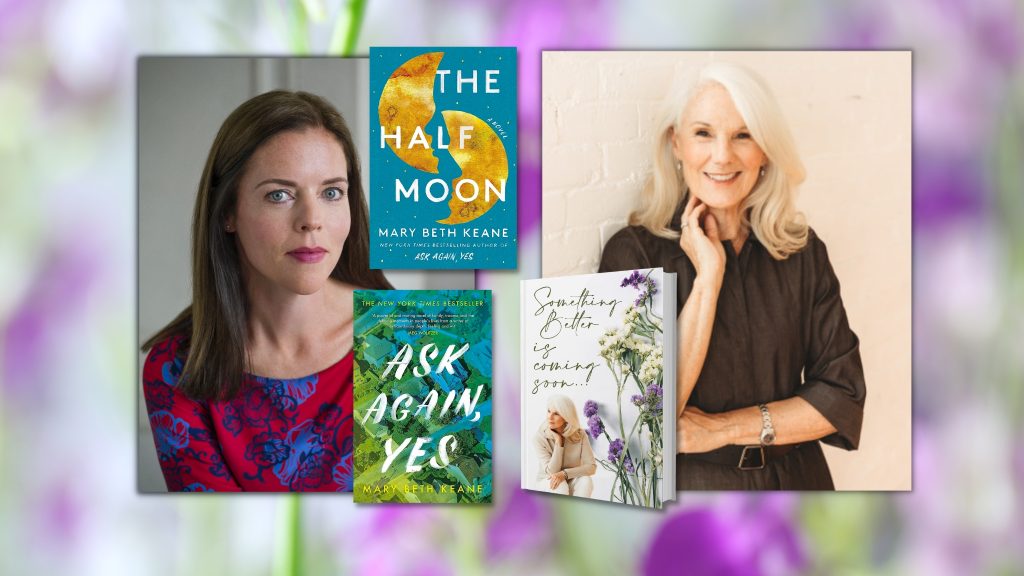
We all love a climactic moment of reconciliation when one person proclaims to another “I forgive you!” in a scene that ends with joyful tears, a loving embrace, and the apparent release of some kind of pixie dust that obliterates all pain. While I long to trust the magic and believe that in a moment reconciliation is complete, something in those scenes gives me pause. I rejoice in them, but I wonder if it could always be that easy.
Mary Beth Keane implies that the answer to that question is often no. In her two most recent novels, the bestselling Ask Again, Yes from 2019 and The Half Moon, released this spring, there are no dramatic scenes of instant healing. Instead, forgiveness is slowly revealed through shifting perceptions, body language, and quiet acceptance achieved over time.
 Ask Again, Yes is the story of Francis Gleeson and Brian Stanhope, rookie cops living side by side in small town Gillam, who imagine a future where their families become lifelong friends. In reality, Anne Stanhope’s mental illness makes that friendship at first difficult and then impossible when she suffers a psychotic break and shoots Francis in the face. He survives, scarred, and does everything in his power to prevent his daughter Kate and the Stanhopes’ son Peter from marrying. In that mission, he fails and so the families become intertwined in a painful way no one would have imagined.
Ask Again, Yes is the story of Francis Gleeson and Brian Stanhope, rookie cops living side by side in small town Gillam, who imagine a future where their families become lifelong friends. In reality, Anne Stanhope’s mental illness makes that friendship at first difficult and then impossible when she suffers a psychotic break and shoots Francis in the face. He survives, scarred, and does everything in his power to prevent his daughter Kate and the Stanhopes’ son Peter from marrying. In that mission, he fails and so the families become intertwined in a painful way no one would have imagined.
The harm from the incident works its way through two generations, leading to infidelity, alcoholism, and estrangement. But the possibility of forgiveness also lies beneath the surface, eventually making itself known in subtle ways. When Francis’s abashed expression confirms his wife Lena’s suspicion that he’s been unfaithful, she receives the blow without saying a word but closes herself against him like “a fist that can’t be opened.”
Later she manages to tell him that things will be okay, “but not yet.” They carry on until eventually it is okay, despite never discussing the subject again. Without fanfare Lena demonstrates her forgiveness by staying in the marriage, caring for Francis, loving him to the other side of her pain. Their slow reconciliation feels genuine.
Francis reveals his forgiveness for Anne in the way his perception of her physical appearance changes. For years he “tried to hate her” but when circumstances compel him to spend time alone with her, he sees a “nervous, quavering” human who presents him no danger. Once he recognizes that she is and has always been weak and vulnerable, he releases his anger so completely that playing with his grandchildren, he jokes “Are you trying to kill me?” forgetting that the woman who once tried to do exactly that is standing in the room.
The book’s title, Ask Again, Yes, refers to Kate and Peter expressing forgiveness by reconfirming their commitment to each other, but Keane employs the word “yes” throughout the book to convey forgiveness among other characters as well. Francis says “yes” to his daughter’s request to put in a good word for the son-in-law he has been unable to love; Kate and Peter say “yes” to Anne and allow her into their family; Kate says “yes” to Peter’s plea for a second chance to get sober; Francis says “yes” when Lena says that all they’ve survived makes them “luckier than most”. In all of these instances “yes” is another word for grace.
 The wrongs in The Half Moon involve matters of trust. In this book, Keane returns to Gillam to tell the story of Malcolm and his lawyer wife Jess, who are struggling on many fronts. They’ve gone into debt to fund years of unsuccessful fertility treatments and the purchase of a bar that Malcolm can barely keep afloat.
The wrongs in The Half Moon involve matters of trust. In this book, Keane returns to Gillam to tell the story of Malcolm and his lawyer wife Jess, who are struggling on many fronts. They’ve gone into debt to fund years of unsuccessful fertility treatments and the purchase of a bar that Malcolm can barely keep afloat.
When the stress of the debt and canceled dreams starts to overwhelm them, Jess turns to another man, which leaves Malcolm on his own to face the frightening consequences of his business dealings with a shady character. Other secrets they’ve kept from each other wreak further damage to their relationship and it’s only when they are teetering on the precipice of complete collapse that they find each other again.
Malcolm can’t imagine forgiving Jess’s betrayal without an apology or “at least a conversation” and yet when no such conversation is forthcoming, he realizes “[h]e didn’t want to get into it … he just wanted to rest … with her body fitted to his” in a physical reconnection that embodies forgiveness.
 I appreciate the subtle forgiveness featured in Keane’s books because it rings true and also because it is at the heart of my own forthcoming novel, Something Better. In my book, a fatal car accident brings together Annabeth Brady, the orphaned 19-year-old daughter of the couple who died, and the Bradys’ friends David and Ruth Crawford, who take Annabeth under their wings. Acting from sincere motivation to help her, the Crawfords veer off course and into catastrophe when David invests too much emotion in Annabeth and Ruth invests too little in her marriage.
I appreciate the subtle forgiveness featured in Keane’s books because it rings true and also because it is at the heart of my own forthcoming novel, Something Better. In my book, a fatal car accident brings together Annabeth Brady, the orphaned 19-year-old daughter of the couple who died, and the Bradys’ friends David and Ruth Crawford, who take Annabeth under their wings. Acting from sincere motivation to help her, the Crawfords veer off course and into catastrophe when David invests too much emotion in Annabeth and Ruth invests too little in her marriage.
I was compelled to explore forgiveness through the lives of these particular people, so accustomed to doing the right thing they can’t admit even to themselves that they might have been careless, let alone done something wrong. With no explicit confession or apology, is forgiveness even possible in the thicket of their well-practiced denial? I won’t reveal here what I discovered about that question (it’s in the book!) but I can promise that readers of Something Better will root for David, Ruth and Annabeth as they try to forgive each other and themselves, bringing fragile hope on a journey with no pixie dust in sight.

